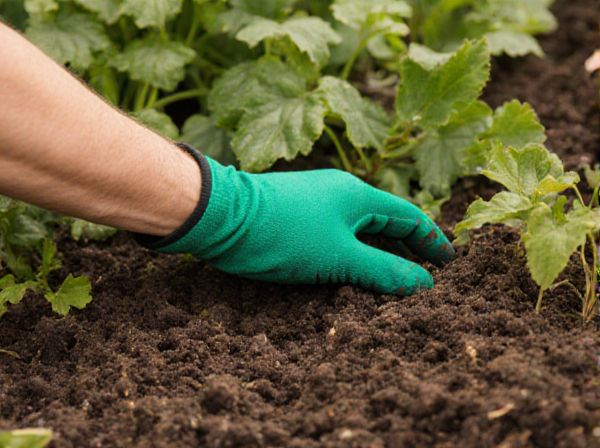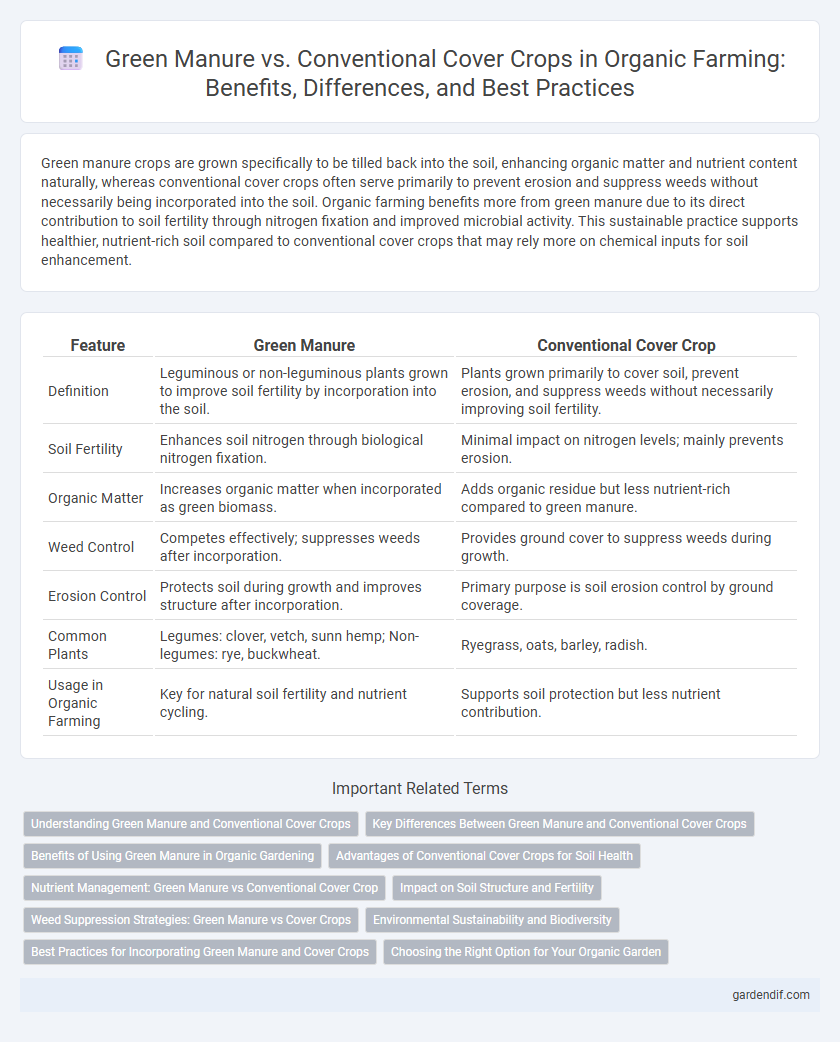
Green Manure vs Conventional Cover Crop Illustration
Green manure crops are grown specifically to be tilled back into the soil, enhancing organic matter and nutrient content naturally, whereas conventional cover crops often serve primarily to prevent erosion and suppress weeds without necessarily being incorporated into the soil. Organic farming benefits more from green manure due to its direct contribution to soil fertility through nitrogen fixation and improved microbial activity. This sustainable practice supports healthier, nutrient-rich soil compared to conventional cover crops that may rely more on chemical inputs for soil enhancement.
Table of Comparison
| Feature | Green Manure | Conventional Cover Crop |
|---|---|---|
| Definition | Leguminous or non-leguminous plants grown to improve soil fertility by incorporation into the soil. | Plants grown primarily to cover soil, prevent erosion, and suppress weeds without necessarily improving soil fertility. |
| Soil Fertility | Enhances soil nitrogen through biological nitrogen fixation. | Minimal impact on nitrogen levels; mainly prevents erosion. |
| Organic Matter | Increases organic matter when incorporated as green biomass. | Adds organic residue but less nutrient-rich compared to green manure. |
| Weed Control | Competes effectively; suppresses weeds after incorporation. | Provides ground cover to suppress weeds during growth. |
| Erosion Control | Protects soil during growth and improves structure after incorporation. | Primary purpose is soil erosion control by ground coverage. |
| Common Plants | Legumes: clover, vetch, sunn hemp; Non-legumes: rye, buckwheat. | Ryegrass, oats, barley, radish. |
| Usage in Organic Farming | Key for natural soil fertility and nutrient cycling. | Supports soil protection but less nutrient contribution. |
Understanding Green Manure and Conventional Cover Crops
Green manure involves growing specific plants, such as legumes or grasses, that are later incorporated into the soil to enhance fertility and organic matter content. Conventional cover crops, typically non-leguminous plants, primarily focus on soil erosion control, moisture retention, and weed suppression without necessarily being tilled into the soil. Understanding the distinct roles of green manure versus conventional cover crops helps optimize soil health management practices in organic farming systems.
Key Differences Between Green Manure and Conventional Cover Crops
Green manure crops, such as legumes and clover, are specifically grown to be incorporated into the soil to enhance nutrient content, particularly nitrogen fixation, improving soil fertility naturally. Conventional cover crops focus primarily on soil protection by reducing erosion, suppressing weeds, and managing soil moisture without necessarily contributing significant nutrients. The key difference lies in green manure's active role in nutrient cycling and soil enrichment, whereas conventional cover crops primarily serve as protective soil covers.
Benefits of Using Green Manure in Organic Gardening
Green manure enhances soil fertility by fixing atmospheric nitrogen, improving soil structure, and increasing organic matter content, essential for sustainable organic gardening. It promotes beneficial microbial activity and suppresses weeds naturally, reducing the need for chemical inputs. Compared to conventional cover crops, green manure is specifically chosen for its nutrient-enriching qualities, aligning with organic standards for healthier crop production.
Advantages of Conventional Cover Crops for Soil Health
Conventional cover crops enhance soil health by improving soil structure, increasing organic matter, and promoting microbial diversity more rapidly than green manure due to their broader crop selection and growth adaptability. They offer superior erosion control and nutrient retention, reducing soil degradation and fertilizer runoff. These benefits lead to improved water infiltration and long-term soil fertility, making them an essential practice in sustainable agriculture.
Nutrient Management: Green Manure vs Conventional Cover Crop
Green manure crops, such as clover and vetch, enhance soil fertility by fixing atmospheric nitrogen directly into the soil, providing a rich, natural nutrient source that reduces the need for synthetic fertilizers. Conventional cover crops, like rye and oats, primarily prevent erosion and improve soil structure but offer lower nitrogen contributions compared to green manure. Effective nutrient management leverages green manure's superior nitrogen fixation to boost organic soil health and promote sustainable crop yields.
Impact on Soil Structure and Fertility
Green manure crops like legumes enhance soil structure by increasing organic matter and promoting microbial activity, leading to improved soil aggregation and nutrient availability. Conventional cover crops primarily prevent erosion and suppress weeds but may not contribute as significantly to nitrogen fixation or soil fertility enhancement. Incorporating green manure into crop rotations fosters long-term soil health through nitrogen enrichment and better tilth compared to conventional cover crops.
Weed Suppression Strategies: Green Manure vs Cover Crops
Green manure crops such as clover and vetch release allelopathic compounds that inhibit weed seed germination, providing effective weed suppression early in the growing season. Conventional cover crops like rye and oats create dense biomass that physically shades and outcompetes weeds, reducing their establishment and growth. Combining green manure with traditional cover crops enhances organic weed management by integrating chemical and physical suppression mechanisms.
Environmental Sustainability and Biodiversity
Green manure enhances environmental sustainability by improving soil fertility and promoting nutrient cycling through nitrogen fixation, unlike many conventional cover crops that primarily focus on erosion control. This practice supports biodiversity by creating habitats for beneficial insects and microorganisms, leading to a balanced ecosystem, whereas conventional cover crops may offer limited ecological benefits. Utilizing green manure reduces reliance on synthetic fertilizers and pesticides, contributing to long-term soil health and resilient agroecosystems.
Best Practices for Incorporating Green Manure and Cover Crops
Incorporating green manure and conventional cover crops involves selecting species based on soil type, nutrient needs, and climate to maximize nitrogen fixation and organic matter addition. Timing of planting and termination is critical, with green manure typically tilled into the soil before flowering to prevent nitrogen loss, while conventional cover crops may be mowed or crimped to create effective mulch. Integrating crop rotations and monitoring soil health indicators enhance the benefits of both practices, improving soil structure, fertility, and moisture retention in organic farming systems.
Choosing the Right Option for Your Organic Garden
Green manure enhances soil fertility by adding nitrogen and organic matter directly through leguminous plants, making it ideal for organic gardens focused on sustainable nutrient cycling. Conventional cover crops provide soil protection and erosion control but may require synthetic fertilizers or more intensive management to achieve similar nutrient benefits. Selecting green manure supports natural soil health and aligns with organic standards, promoting long-term garden productivity and ecological balance.
Green Manure vs Conventional Cover Crop Infographic

 gardendif.com
gardendif.com